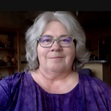Hazel Thornton's Blog, page 4
February 22, 2024
Money Mondays: Are You Paying Your Money Enough Attention?
Call it what you will — The Law of Circulation, Feng Shui, The Principle-of-Not-Getting-Your-Lights-Turned-Off-Because-You-Forgot-to-Pay-the-Bill — money ebbs and flows and takes on a life of its own.
Managing money is like raising children who act up, demanding negative attention if they aren’t getting enough positive attention.
Whether you think you’re rich or poor — well, that’s part of the problem, isn’t it? What we think and feel and believe about money has a huge effect on how we deal with it. I’ve had “poor” clients who live with a scarcity mentality, being loath to spend any money at all for fear that they might never get any more than they already have. And I’ve had “rich” ones who, despite their ability to pay, simply do not always pay their bills on time, incurring financial consequences.
But we can all improve our situations a bit at a time by paying more attention to our finances.
Managing money is like raising children who act up, demanding negative attention if they aren't getting enough positive attention.
Click To Tweet
Paying your money regular attention on Money Mondays will help you avoid late fees, worry, stress, missed opportunities, and legal problems.
Click To Tweet
Don’t try to do it all in one day, just do a little more on each Money Monday. (Unless, of course, you are facing a looming deadline with a penalty.)
From the Cash Flow Clutter chapter of Go With the Flow! (The Clutter Flow Chart Workbook):
Cash Flow clutter comes in the form of outdated financial records (like pay stubs and utility bills from the 20th century), and lingering financial tasks (such as unfiled tax returns, incomplete insurance claims, and postponed financial decisions).
Money likes attention, and if you don’t pay it regular positive attention it will demand negative attention in the form of late fees, worry, stress, missed opportunities and legal problems.
Beware of financial icebergs!Of course, this is just the tip of the financial iceberg. As you focus on your money you may uncover issues you didn’t even realize you had. (I’ve been double billed for how long?! Dang, I wanted to cancel that subscription before it renewed itself!)
Ask for help, if you need it, from an organizing, financial, or legal professional. It will pay off in the long run, I promise!
Are you paying your money enough attention?
How do you make dealing with money easier for yourself?
Please share with us in the comments below!
______________________________________________________Hazel Thornton is an author, genealogist, and retired home and office organizer.Hung Jury: The Diary of a Menendez Juror What’s a Photo Without the Story? How to Create Your Family Legacy Go With the Flow! The Clutter Flow Chart Workbook Feel free to link directly to this post! Click here to ask about other uses.Copyright 2013-2024 by Hazel Thornton, Organized for Life and Beyond
___________________________________________________________
The post Money Mondays: Are You Paying Your Money Enough Attention? appeared first on Hazel Thornton.
February 16, 2024
Witches in the Family
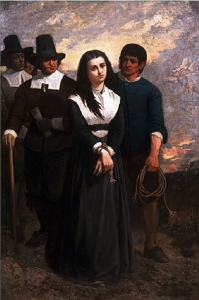
Witch Hill (The Salem Martyr) painting by Thomas Satterwhite Noble 1869
Yikes! Witches? Really?
Well, suspected and accused in court, yes!
Convicted and hanged, thankfully not!
In which I fall down the rabbit hole of finding out that one of my ancestors was accused of witchcraft in 1667 Connecticut.
Click To Tweet

You’ve no doubt heard about the Salem Witch Trials in 1692-3 Massachusetts.
But what about the Connecticut Witch Trials that predated them by 30 years?
Yeah, me neither.

Hartford Founders Monument
The Salem trials were more numerous and better publicized, but the trials in Connecticut towns such as Hartford, Wethersfield, Old Saybrook, and Old Lyme were equally tragic to those involved.
I knew from my genealogy research that I had ancestors who lived “up there”, and “back then”, but nothing that connected them directly to Salem in 1692-3.
I even visited the area, 30 years ago, to research some of my ancestors (surnames Ingersoll, Kibbe, Cooke, Kelsey, Pratt, Lord) and see where they had lived and died. My mom, aunt, and a family friend were on the lookout for fall foliage, gravestones, and statues with our ancestors’ names on them.
Who knew that I would later discover that my 10th great-grandmother, Anna Wolcott Griswold, was accused of witchcraft in 1667 in nearby Old Lyme? (Or, as it was known then, just Lyme.)
To be fair, I didn’t even know I had a 10th great-grandmother named Anna Wolcott Griswold until now.
.How did I, all of a sudden, learn about Anna Wolcott Griswold? It started with Maureen Taylor sending me an email with the subject line: “Are You Related to The Photo Detective?” (OK, she sent it to her entire newsletter mailing list.)
It started with Maureen Taylor sending me an email with the subject line: “Are You Related to The Photo Detective?” (OK, she sent it to her entire newsletter mailing list.)
Maureen was one of the trusted experts featured in my book What’s a Photo Without the Story? How to Create Your Family Legacy. She helped me figure out the story behind the book’s cover image of my namesake bathing beauty grandmother. Maureen, like most genealogists (both amateur and professional) is preparing for RootsTech, the largest annual genealogy conference in the world, coming up later this month. The link she posted in her newsletter is one of my favorite features: Relatives at RootsTech. I have written about it before and posted my own links on Facebook. (Scroll down to see my link in this post.)
The idea is that if you have built your family tree back far enough (often only a couple of generations will do it) it will connect to the world family tree in FamilySearch and their computer will be able to calculate how you are related to others who have done the same. Granted, it could be quite a distant relationship. Maureen and I are 11th cousins once removed, but the fact remains we’re related because we have common ancestors. Maureen’s 9th grandfather was my Anna’s brother George, and their parents were Henry Wolcott (1578-1655) and Elizabeth Saunders (1584-1655).
(OK, now I’m wondering how they both died in 1655. The genealogy rabbit hole never hits bottom!)
.
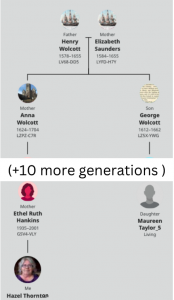
Sidebar: What the heck is a second cousin once removed?
.How do I know we’re really related, though?Because I did the research on my side myself.
The accuracy of the FamilySearch world tree depends entirely on its users and the documentation they have used and cited. The first thing I do when FamilySearch suggests I’m related to someone is to check my side of the match to see how far back I have already proven that line. When I get to someone I don’t “know”, I stop and think about whether it could be true and start looking for documentation to support (or refute) it. In this instance I was two generations short of our alleged common ancestors, but those two generations were easily proven.
.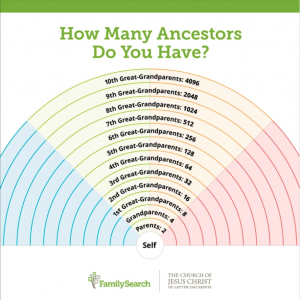
Click image to learn more.
Do the mathCould I have learned about my 10th great-grandmother without Maureen Taylor asking, “Are we related?” Sure! But consider this: At the 10th great-grandparent level I have 4096 ancestors. No, really! Just take a look at the “How Many Ancestors Do You Have?” chart.

RootsTech updates the number as more people join.
It’s this math that makes me believe it when FamilySearch tells me I have 13,840 relatives at RootsTech. Just think how many descendants those 4096 ancestors must have by now! (Only a fraction of them will be attending RootsTech.)
There are so many ancestors to research, and there is so much history to learn, that it’s possible I might never have returned to that particular branch of the family on my own due to having so many others to occupy my time and my imagination. So, thanks, Maureen!
.But wait, what happened to Anna Wolcott Griswold?Records are scarce as to the details, but apparently it was her neighbor, John Tillerson, who accused her of witchcraft. Fortunately her family was well-respected and she had a supportive, level-headed husband, Matthew Griswold. They refuted that claim, accusing Tillerson, in turn, of slander, which was also taken seriously in those days. The Griswolds won the case, but Tillerson was poor and the Griswolds did not receive monetary compensation. Their reward was that the court’s opinion was published widely and Tillerson had to pay court costs: 7 shillings for the express warrant and 5 shillings for the constable.
So it could have turned out much worse for Anna. Can you imagine being accused of witchcraft in that time and place?
.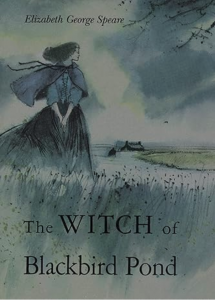
The Witch of Blackbird Pond, by Elizabeth George Speare
Full circle momentMaybe it was in my DNA to love the Newbery-Award-winning book The Witch of Blackbird Pond, by Elizabeth George Speare, when I read it in fifth grade. Same time frame. Same location. Although the book is set in Connecticut, I didn’t remember that half a century later. Conversely, I don’t know that at age 10 I had yet learned about the Salem witch trials.
In re-reading it, I think the “witch”, elderly widow Hannah Tupper, got off easy. She had been persecuted as a Quaker in Massachusetts and driven away to live as an outcast in predominantly Puritan Weathersfield, Connecticut. (I had no idea at age 10 that I was descended from a long line of Quakers on my dad’s side!) The protagonist, 16 year old Kit Tyler, an English girl who had been raised in Barbados, was also accused of practicing witchcraft. She was a non-practicing Catholic who could read, and — gasp — swim! Remember, it was thought that only witches floated; the innocent sank in water and often drowned while proving their innocence. Kit’s biggest sin, however, was that she befriended Hannah. They were both were blamed for a wave of sickness in town and suffered the wrath of the community, at least to the extent that a fifth grader can handle. One source says it is inaccurate that a Quaker would have been persecuted in Connecticut (and it is a work of fiction, after all), but I don’t know — based on my research, I think they doth protest too much.
This book was one of my earliest exposures to injustice — along with To Kill a Mockingbird by Harper Lee — and to how hateful and unfair people can be towards someone who is different than they are.
.My ancestors are all immigrants, and yours probably are tooNearly all of the branches of my family (that I have researched) arrived in America during the 1600’s. So I have not gotten to do any Ellis Island research for myself, and very little across-the-pond research, either. But make no mistake — they were ALL immigrants. (Well, except for one woman whom cousins claim was Native American, but without any satisfactory proof.) Although I do qualify, I’ve never been tempted to join the DAR (Daughters of the American Revolution), largely because of their hoity-toity reputation. It’s possible that over time they have redeemed themselves with modern day attitudes and good works, I don’t really know.
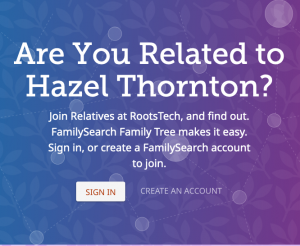
Click image to find out!
I am, however, at least a little bit tempted to join the Associated Daughters of Early American Witches, a hereditary/lineage society for female direct descendants of the victims of the colonial witchcraft trials. They list Anna Wolcott Griswold as a qualifying member.
Do you have any (falsely accused) witches in your family tree?
Are you planning to attend RootsTech?
What is your favorite RootsTech tool or feature?
Please share with us in the comments below.
And…are we related? Click here to find out!
______________________________________________________Hazel Thornton is an author, genealogist, and retired home and office organizer.Hung Jury: The Diary of a Menendez Juror What’s a Photo Without the Story? How to Create Your Family Legacy Go With the Flow! The Clutter Flow Chart Workbook Feel free to link directly to this post! Click here to ask about other uses.Copyright 2024 by Hazel Thornton, Organized for Life and Beyond
___________________________________________________________
The post Witches in the Family appeared first on Hazel Thornton.
Witches in the Family?

Witch Hill (The Salem Martyr) painting by Thomas Satterwhite Noble 1869
Yikes! Witches? Really?
Well, suspected and accused in court, yes!
Convicted and hanged, thankfully not!
In which I fall down the rabbit hole of finding out that one of my ancestors was accused of witchcraft in 1667 Connecticut.
Click To Tweet

You’ve no doubt heard about the Salem Witch Trials in 1692-3 Massachusetts.
But what about the Connecticut Witch Trials that predated them by 30 years?
Yeah, me neither.

Hartford Founders Monument
The Salem trials were more numerous and better publicized, but the trials in Connecticut towns such as Hartford, Wethersfield, Old Saybrook, and Old Lyme were equally tragic to those involved.
I knew from my genealogy research that I had ancestors who lived “up there”, and “back then”, but nothing that connected them directly to Salem in 1692-3.
I even visited the area, 30 years ago, to research some of my ancestors (surnames Ingersoll, Kibbe, Cooke, Kelsey, Pratt, Lord) and see where they had lived and died. My mom, aunt, and a family friend were on the lookout for fall foliage, gravestones, and statues with our ancestors’ names on them.
Who knew that I would later discover that my 10th great-grandmother, Anna Wolcott Griswold, was accused of witchcraft in 1667 in nearby Old Lyme? (Or, as it was known then, just Lyme.)
To be fair, I didn’t even know I had a 10th great-grandmother named Anna Wolcott Griswold until now.
.How did I, all of a sudden, learn about Anna Wolcott Griswold? It started with Maureen Taylor sending me an email with the subject line: “Are You Related to The Photo Detective?” (OK, she sent it to her entire newsletter mailing list.)
It started with Maureen Taylor sending me an email with the subject line: “Are You Related to The Photo Detective?” (OK, she sent it to her entire newsletter mailing list.)
Maureen was one of the trusted experts featured in my book What’s a Photo Without the Story? How to Create Your Family Legacy. She helped me figure out the story behind the book’s cover image of my namesake bathing beauty grandmother. Maureen, like most genealogists (both amateur and professional) is preparing for RootsTech, the largest annual genealogy conference in the world, coming up later this month. The link she posted in her newsletter is one of my favorite features: Relatives at RootsTech. I have written about it before and posted my own links on Facebook. (Scroll down to see my link in this post.)
The idea is that if you have built your family tree back far enough (often only a couple of generations will do it) it will connect to the world family tree in FamilySearch and their computer will be able to calculate how you are related to others who have done the same. Granted, it could be quite a distant relationship. Maureen and I are 11th cousins once removed, but the fact remains we’re related because we have common ancestors. Maureen’s 9th grandfather was my Anna’s brother George, and their parents were Henry Wolcott (1578-1655) and Elizabeth Saunders (1584-1655).
(OK, now I’m wondering how they both died in 1655. The genealogy rabbit hole never hits bottom!)
.

Sidebar: What the heck is a second cousin once removed?
.How do I know we’re really related, though?Because I did the research on my side myself.
The accuracy of the FamilySearch world tree depends entirely on its users and the documentation they have used and cited. The first thing I do when FamilySearch suggests I’m related to someone is to check my side of the match to see how far back I have already proven that line. When I get to someone I don’t “know”, I stop and think about whether it could be true and start looking for documentation to support (or refute) it. In this instance I was two generations short of our alleged common ancestors, but those two generations were easily proven.
.
Click image to learn more.
Do the mathCould I have learned about my 10th great-grandmother without Maureen Taylor asking, “Are we related?” Sure! But consider this: At the 10th great-grandparent level I have 4096 ancestors. No, really! Just take a look at the “How Many Ancestors Do You Have?” chart.

RootsTech updates the number as more people join.
It’s this math that makes me believe it when FamilySearch tells me I have 13,840 relatives at RootsTech. Just think how many descendants those 4096 ancestors must have by now! (Only a fraction of them will be attending RootsTech.)
There are so many ancestors to research, and there is so much history to learn, that it’s possible I might never have returned to that particular branch of the family on my own due to having so many others to occupy my time and my imagination. So, thanks, Maureen!
.But wait, what happened to Anna Wolcott Griswold?Records are scarce as to the details, but apparently it was her neighbor, John Tillerson, who accused her of witchcraft. Fortunately her family was well-respected and she had a supportive, level-headed husband, Matthew Griswold. They refuted that claim, accusing Tillerson, in turn, of slander, which was also taken seriously in those days. The Griswolds won the case, but Tillerson was poor and the Griswolds did not receive monetary compensation. Their reward was that the court’s opinion was published widely and Tillerson had to pay court costs: 7 shillings for the express warrant and 5 shillings for the constable.
So it could have turned out much worse for Anna. Can you imagine being accused of witchcraft in that time and place?
.
The Witch of Blackbird Pond, by Elizabeth George Speare
Full circle momentMaybe it was in my DNA to love the Newbery-Award-winning book The Witch of Blackbird Pond, by Elizabeth George Speare, when I read it in fifth grade. Same time frame. Same location. Although the book is set in Connecticut, I didn’t remember that half a century later. Conversely, I don’t know that at age 10 I had yet learned about the Salem witch trials.
In re-reading it, I think the “witch”, elderly widow Hannah Tupper, got off easy. She had been persecuted as a Quaker in Massachusetts and driven away to live as an outcast in predominantly Puritan Weathersfield, Connecticut. (I had no idea at age 10 that I was descended from a long line of Quakers on my dad’s side!) The protagonist, 16 year old Kit Tyler, an English girl who had been raised in Barbados, was also accused of practicing witchcraft. She was a non-practicing Catholic who could read, and — gasp — swim! Remember, it was thought that only witches floated; the innocent sank in water and often drowned while proving their innocence. Kit’s biggest sin, however, was that she befriended Hannah. They were both were blamed for a wave of sickness in town and suffered the wrath of the community, at least to the extent that a fifth grader can handle. One source says it is inaccurate that a Quaker would have been persecuted in Connecticut (and it is a work of fiction, after all), but I don’t know — based on my research, I think they doth protest too much.
This book was one of my earliest exposures to injustice — along with To Kill a Mockingbird by Harper Lee — and to how hateful and unfair people can be towards someone who is different than they are.
.My ancestors are all immigrants, and yours probably are tooNearly all of the branches of my family (that I have researched) arrived in America during the 1600’s. So I have not gotten to do any Ellis Island research for myself, and very little across-the-pond research, either. But make no mistake — they were ALL immigrants. (Well, except for one woman whom cousins claim was Native American, but without any satisfactory proof.) Although I do qualify, I’ve never been tempted to join the DAR (Daughters of the American Revolution), largely because of their hoity-toity reputation. It’s possible that over time they have redeemed themselves with modern day attitudes and good works, I don’t really know.

Click image to find out!
I am, however, at least a little bit tempted to join the Associated Daughters of Early American Witches, a hereditary/lineage society for female direct descendants of the victims of the colonial witchcraft trials. They list Anna Wolcott Griswold as a qualifying member.
Do you have any (falsely accused) witches in your family tree?
Are you planning to attend RootsTech?
What is your favorite RootsTech tool or feature?
Please share with us in the comments below.
And…are we related? Click here to find out!
______________________________________________________Hazel Thornton is an author, genealogist, and retired home and office organizer.Hung Jury: The Diary of a Menendez Juror What’s a Photo Without the Story? How to Create Your Family Legacy Go With the Flow! The Clutter Flow Chart Workbook Feel free to link directly to this post! Click here to ask about other uses.Copyright 2024 by Hazel Thornton, Organized for Life and Beyond
___________________________________________________________
The post Witches in the Family? appeared first on Hazel Thornton.
January 30, 2024
Menendez: 30 years ago
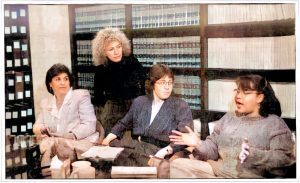
January 29, 1994 press conference in Leslie Abramson’s law office.
30 years ago this week, in late January 1994, both juries were declared hopelessly deadlocked in the first Menendez brothers murder trial.
Who knew that 30 years later they would still be behind bars?
Who knew that 30 years later the Menendez brothers would still be behind bars? Enough is enough! Set them free.
Click To Tweet
I always say that Erik’s jury deliberated for a month — rather than reporting days or hours — because that’s how much of our lives was spent on it. The trial (including a month of jury selection) occupied our brains every waking moment, including weekends, for seven months altogether. We exhausted every avenue of reconciliation before reluctantly giving up and allowing the judge to declare a mistrial.
Lyle’s jury took two weeks longer to admit defeat, in part because they were interrupted by the 8.7 Northridge earthquake. Well, most everyone was asleep at 4:00 a.m, when they were rudely shaken out of their beds, but deliberations were delayed briefly as a result and had to move to a different location.
Both juries were split roughly along gender lines, with men leaning towards murder and women leaning towards manslaughter. Erik’s jurors were evenly divided — 6 men, 6 women. An unfortunate initial show of hands started us down a path of no return that no amount of deliberating, arguing, fist pounding on the table, or name-calling could save us from. It was later (and is still, to this day) reported that we couldn’t DECIDE on a verdict. Oh, we each decided, all right. But we couldn’t AGREE on a verdict.
Press ConferenceErik’s jury was not allowed to speak publicly about the trial until Lyle’s jury was finished deliberating. By then the women on Erik’s jury had attended a dinner at defense attorney Leslie Abramson’s house (something that used to be the first thing every reporter asked me about), and she had arranged for some of us to speak to the press when the time came.
On Saturday, 1/29/94, Leslie Abramson, “her girls”, and a handful of trusted journalists (trusted to be fair and not prosecution-biased, that is), including Robert Rand and Linda Deutsch, gathered in her law office for a press conference. News of Erik’s jury room gender split made headlines across the country on Sunday, 1/30/94, but I didn’t know that until many years later.
Fast forward 20 years (or so), to a time when I had a subscription to Newspapers.com. As any good genealogist would, I searched for both elusive and prominent ancestors; my grandparents; my parents; and myself. I found a few articles I hadn’t seen before — my 8th birthday party in small town Cayuga, Indiana; the new preacher’s family coming to Boise, Idaho; one of my Junior High piano recitals; and — wait, what’s this? Dozens and dozens of articles dated January 30, 1994.
Sure, I knew it was a big trial and had been covered by Court TV and all. But I had no idea how many newspapers across the country had published stories about the two hung juries and specifically about the gender split on Erik’s jury. They mostly ran a handful of the same few articles, because there had been only a handful of reporters at the press conference. And most of them used the photo I’ve included above. But some newspapers printed longer articles, and included different photos. And they all had different headlines.

Headlines January 29-31, 1994
Menendez 30 years later
Here are just a few highlights — good and bad — of the past 30 years:
My trial diary was published in 1995, and was almost immediately eclipsed by the shadow of the O.J. Simpson double murder trial, the new “trial of the century”.The second trial, in 1995-6, was successfully and cruelly engineered by the judge and the DA to guarantee murder convictions. (As described in the “20 years later” edition of my book.)A resurgence of public interest began in 2016 and continues today, triggering what I call The Menendez Miracles, a post containing more highlights!A new habeas corpus petition was filed in May 2023 to reopen the case. It is still being considered by a judge as I write.The women in the first trial did not see the brothers as innocent. But most of us gave them the benefit of our reasonable doubt that they had killed out of fear (imperfect self-defense) and had not planned it (murder). The burden of proof was on the prosecution, after all, to prove the elements of murder. The burden was not on the defense prove the various types of abuse alleged by the brothers and corroborated by a parade of family members, coaches, teachers, and expert witnesses.
The maximum penalty for manslaughter would have been 11 years per count (per parent killed), or 22 years total (per brother). Given that they were arrested in March 1990, that means they’ve been behind bars for nearly 34 years. Enough is enough! They should have been released years ago.
ResourcesEnough is Enough: The Menendez Tapestry (4 min. video)
30 years as a Menendez juror (1 min. video)
“30 years ago today” TikTok campaign
Website: http://menendezjuror.com
Book: Hung Jury: The Diary of a Menendez Juror
Social media: @menendezjuror on TikTok, Instagram, Twitter
What is Your Verdict? (flow chart)
Please share this post on social media and with anyone else you’d like to enlighten about the case!
Please leave a comment below…..that is, unless you are un-supportive of me or the brothers, in which case please refrain from commenting. Thank you!
______________________________________________________Hazel Thornton is an author, genealogist, and retired home and office organizer.Hung Jury: The Diary of a Menendez Juror What’s a Photo Without the Story? How to Create Your Family Legacy Go With the Flow! The Clutter Flow Chart Workbook Feel free to link directly to this post! Click here to ask about other uses.Copyright 2024 by Hazel Thornton, Organized for Life and Beyond
___________________________________________________________
The post Menendez: 30 years ago appeared first on Hazel Thornton.
January 29, 2024
Don’t forget to remember!
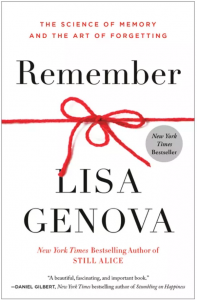
As a professional organizer it was part of my job to help people find ways to remember stuff:
Where are my keys?Where does this go?How do I remember tasks?Why do I forget appointments?Why can I never find the remote?Together, we created solutions and systems ala takeaways #2, 8, 9 in the list below.
Often they worry that forgetting things is a sign of Alzheimer’s. So, one time I wrote a blog post called “No, you don’t have Alzheimer’s!” Then I got a client who was worried about getting the dreaded disease on the basis that it ran in her family. Oops. I didn’t want to be flippant about it. So I renamed the blog post Getting Organized Prevents Memory Loss. Which isn’t quite right either. I mean, if you really do have it, getting organized will help…a lot…for awhile…
The post included a couple of statistics about Alzheimers, and why you probably don’t have it, but, well, I’m no neuroscientist.
Enter Lisa Genova, who is a neuroscientist.
It's comforting to know that forgetting is normal, but it helps to understand why it happens and what we can do to remember important things.
Click To Tweet
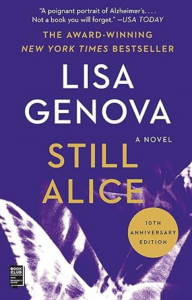 Many years ago I read, and loved, Lisa’s novel Still Alice. It chronicles fictional Alice’s descent into Alzheimers, so yeah, it’s sad. But it’s also funny, and touching, and ever-so-insightful. Eventually, Juliette Moore won an Oscar for playing the movie version of Alice, which I also recommend.
Many years ago I read, and loved, Lisa’s novel Still Alice. It chronicles fictional Alice’s descent into Alzheimers, so yeah, it’s sad. But it’s also funny, and touching, and ever-so-insightful. Eventually, Juliette Moore won an Oscar for playing the movie version of Alice, which I also recommend.
But I didn’t know the author was an actual neuroscientist until I learned about her 2021 book called Remember: The Science of Memory and the Art of Forgetting.
I uncharacteristically chose the book for my book club without having read it first. I figured if a neuroscientist could write Still Alice, her non-fiction book might also be quite readable. And I was right! We just met and discussed it, so I’m writing this now before I — ahem — forget what I want to say about it.
My goal was to help everyone (including myself) to feel better about forgetting stuff, while also gaining insight into why it happens and what we can do when it’s important to remember.
My main takeaways
Forgetting is normal. Yes, it happens more with age, but that doesn’t mean you have Alzheimers. (See? I was right!) Can you imagine how cluttered your brain would be if you never forgot anything? (Lisa describes a few people like that in the book and it’s not as fun as you might think.)
You can’t remember something you never paid attention to in the first place, like where your car is parked. (Solution: Pay attention. Be mindful. Easier said than done, but worth it.)
Not being able to find your keys is normal. (Solution: Create a “home” for them and pay attention when you set them down.) Finding them in the refrigerator might indicate a problem. You probably do have Alzheimer’s if you look at your keys and don’t know what they are for.
Everyone in the book club agreed that the book has made them feel more forgiving of themselves when they forget things. They now have more tools for remembering. And it has made them more understanding of others who forget. It’s comforting to know that forgetting is normal, but it helps to know why it happens and what we can do to remember important things.
More takeaways
Here are the top 10 takeaways from Remember according to the terrific Book Club Kit on Lisa Genova’s website (please think of this as a preview and read the whole book if you’re the least bit interested in this subject):
Effective remembering often requires forgetting.Attention is essential for creating a memory of anything. You can’t remember what you didn’t pay attention to.We don’t remember most of our lives.A full night’s sleep enhances your ability to establish long-term memories and reduces your risk of Alzheimer’s.Your memories of what happened are full of additions, omissions, elaborations, and errors.Being chronically stressed about your memory will impair it.Emotional experiences are better remembered than neutral ones.Repetition makes your memories stronger.Prospective memory is your memory for what you need to do later. Our brains are terrible at this. Use To-Do lists, calendars, and sticky notes instead of your brain.We remember what is meaningful.My Goodreads rating: 5 stars! *****
Book Club discussion rating: Excellent!
Alzheimer’s
Although two of the eighteen book chapters are about Alzheimer’s, this section of the post is from me, not from Lisa Genova.
As the Alzheimer’s Association website states:
There is no single test that can determine if a person is living with Alzheimer’s or another dementia. Physicians use diagnostic tools combined with medical history and other information, including neurological exams, cognitive and functional assessments, brain imaging (MRI, CT, PET) and cerebrospinal fluid or blood tests to make an accurate diagnosis.
The website goes on to list a number of types of available tests, treatments, and additional helpful information.
And, because I’m a genealogist with an interest in DNA testing, of course I Googled “Alzheimer’s DNA test”. As the National Institute on Aging website states:
In most cases, Alzheimer’s does not have a single genetic cause. Instead, it can be influenced by multiple genes in combination with lifestyle and environmental factors. Consequently, a person may carry more than one genetic variant or group of variants that can either increase or reduce the risk of Alzheimer’s.
Importantly, people who develop Alzheimer’s do not always have a history of the disease in their families. Still, those who have a parent or sibling diagnosed with the disease have a higher risk of developing Alzheimer’s than those without that association.
So, it sounds like DNA testing would be less than conclusive.
I understand that getting oneself tested, in whatever way, can be super-scary. But if my family had a history of it, I would want to know where I stand. And I would want to learn as much as possible about the latest treatments. If drugs would allow me to maintain my current cognitive level I would take them. But, for the record, if I had deteriorated to the point where I couldn’t even make these sorts of decisions for myself, I would not want drugs to prolong my life.
Memory Roundup
For your convenience — and mine —I have gathered a number of my previous blog posts related to memory. (I could have suggested that you search my site for the keyword “memory”, but that list would also include all the posts about memorializing loved ones, organizing keepsakes, and leaving a legacy.)
Getting Organized Prevents Memory Loss
Wanna know my #1 time management tip?
It’s All About the Labels (not the label makers)
What is Your Clutter Costing You?
How to Live and Work by Design, not by Default
Why do I take before and after photos?
This Photo Trick Cures Clutter Amnesia!
More mindfulness. Less clutter.
If you can’t find something, clean up!
There’s no Reason to Freak out…Unless…
Do you have trouble remembering, and do you worry about forgetting?
Are you familiar with Lisa Genova? Might you read her book(s)?
What memory tricks do you like and want to share with us in the comments below?
______________________________________________________Hazel Thornton is an author, genealogist, and retired home and office organizer.Hung Jury: The Diary of a Menendez Juror What’s a Photo Without the Story? How to Create Your Family Legacy Go With the Flow! The Clutter Flow Chart Workbook Feel free to link directly to this post! Click here to ask about other uses.Copyright 2024 by Hazel Thornton, Organized for Life and Beyond
___________________________________________________________
.
The post Don’t forget to remember! appeared first on Hazel Thornton.
January 22, 2024
Inspirational flow charts, graphics, and cartoons

“World’s most accurate pie chart.” Creator unknown. (Click image to see the earliest use of this chart that I could find.)
If you know me at all, you know I love flow charts, graphics, and cartoons!
I also love when people send them to me. I don’t care if they’re graphs, pie charts, or Venn diagrams. Sometimes I’ve seen them before, but you never know — what if I haven’t?
I love flow charts, graphics, and cartoons! These days, the simpler the better. Here are some of my favorites.
Click To Tweet
It’s been a while since I’ve added to this album, but I used to post one each week on my Facebook biz page: FRIDAY FLOW CHARTS (& Other Graphics I Like). Looks like this feature ran from mid-2012 to early-2015. Many of them are unattributed, and are also presumably one-offs.
Looking back, I notice that many of the charts are very busy. The best ones have a humorous twist, such as all paths leading to “eat the cookie”. Sometimes though, for me these days, the simpler the better.
Here’s one I love that a great number of people on the internet have also used. And here’s a link in which the artist, Henck van Bilsen, was identified by the person I had previously thought to be the originator.


Instagram page with lots of examples
(Janis agreed, via email, that I could use my choice of his art in this post. There are so many good ones it was hard to decide!)
Liz and Mollie
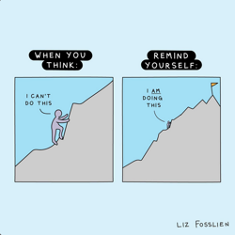
Instagram page with lots of examples
Liz’s website addresses licensing.
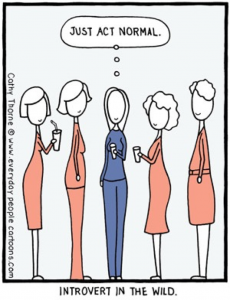
Instagram page with lots of examples
I licensed this cartoon to illustrate my NAPO2017 presentation, Networking for Introverts.
.While I’m at it:

“You’ve read the tabloids. You’ve seen the T.V. movie. You’ve watched the talk shows. It’s up to you.”
Einstein’s Cousins is a favorite genealogy cartoon I did NOT receive permission (not without paying a fee I couldn’t afford) to use in my blog post, What the heck is a second cousin once removed?
And here are some cartoons by John Callahan that were published in the Los Angeles Times during the first Menendez trial. I licensed one of them for my use in 1994, and was sent several others in the bargain: Callahan Courtroom Cartoons
 Go with the flow!
Go with the flow!Last year I published my own book of flow charts: Go With the Flow! The Clutter Flow Chart Workbook. I created and released them periodically over the years. As it turns out, the workbook includes all 17 charts which, happily, equals the number of years I worked with clients as a professional organizer.
Click here (and scroll down) to download your complimentary copy of The Original Clutter Flow Chart!
.
What are your favorite flow charts, graphics, and cartoons?
Please share with us in the comments below!
______________________________________________________Hazel Thornton is an author, genealogist, and retired home and office organizer.Hung Jury: The Diary of a Menendez Juror What’s a Photo Without the Story? How to Create Your Family Legacy Go With the Flow! The Clutter Flow Chart Workbook Feel free to link directly to this post! Click here to ask about other uses.Copyright 2024 by Hazel Thornton, Organized for Life and Beyond
___________________________________________________________
The post Inspirational flow charts, graphics, and cartoons appeared first on Hazel Thornton.
January 15, 2024
Do I Practice What I Preach? (Habits, Maintenance, and Backsliding)

I don’t know what I’m “preaching” about here, but this Jumbotron photo from NAPO2014 cracks me up!
Dear Readers: I hope you enjoy this refreshed post from 2016.
I was helping a long-time virtual coaching client with email maintenance, teaching her about Inbox Zero, and I admitted that mine was currently more like Inbox 200. In fact, as I continued to say, I don’t do anything (maintenance-wise) every day.
She was relieved to hear it.
Is it backsliding if you skip a day on purpose? Maybe you've just found your sweet spot.
Click To Tweet
Clients seem to enjoy it when I admit to shortcomings, I guess because it makes me seem more human. More like them. Which I am, in more ways than not.
Here are some of my written confessions:Confessions of a Professional Organizer (I’m organized enough, and not one bit more.)How Clean Does Your House Really Need To Be?Does Your System Need Tweaking Like Mine Did?Is Your Kitchen Counter Worse Than Mine?If You Can’t Find Something Clean Up!So, do I practice what I preach? Yes, and no.
Do I make my bed, do my dishes, and sort my mail into an action file every single day without fail? No.
Do I put things away that I got out to use during the day? Yes. Always? No.
But I do these things more days than not.
Do I think it’s OK to skip a day, or a week? Yes, I do. But it wouldn’t work for everyone. And I don’t think that pointing out loopholes right up front would be helpful. It would be like telling a teenager: “OK, you know the speed limit is 60, right? But if you are careful, and if traffic is light, and if there are no cops around, you can probably get away with going 70.” It might be true, and there might be some students in the class who would keep that concept in mind and not abuse it, but what self-respecting drivers training instructor would actually say that to a student? Do they do it themselves, though? Probably.
Habits make things easierThe point of creating a daily habit is that you don’t have to think, every day, “Am I going to do it today? If not, when am I going to do it?” It’s SO MUCH EASIER to just do it daily. I have a few good habits, and a few bad ones. I am, according to the Four Tendencies quiz in Gretchen Rubin’s book Better Than Before, a Questioner — with a streak of Rebel, which does not help one little bit. So I tend to make things harder on myself than they would be for, say, an Upholder or an Obliger.
Do I practice most of the things I preach most of the time? Yes. Often enough that if you visited my home, or examined my calendar, you would agree I am pretty organized! Can I find my scissors when I need them? Yes. Do I get things done on time? Yes. Can I help others get organized? Absolutely!
Besides, whoever said getting organized and staying that way was easy?
Certainly not me. Case in point:
Getting Organized Once And For AllWHY I Love ChoresBeing Organized Isn’t EasyHow Can Less be More?Find maintenance strategies that work for youHere are a few examples:
Don’t break the chain! (Keep track of what you did on a calendar or chart.)Make rules for yourself such as: “I can skip one day (or week, if it’s a weekly task), but I can’t skip two.” (I’ll warn you, though, it’s a slippery slope and not for everyone.)Create a mantra that works for you. Mine is: Progress equals Happiness. Find your sweet spot. (How clean does your house really need to be?).Read Gretchen Rubin’s book (mentioned above) to learn strategies that will work for your tendency. And to learn what loopholes you use without even realizing it.Learn to live and work by design, not by default.Expect that you will get off track periodically, and learn how to get back on track easily.Know this: Backsliding is normalEverybody takes a day off now and then. And things happen, like illness, travel, and emergencies. And things slide — the house gets messy or you forget an appointment because your system of task and calendar management got interrupted.
It’s not that it was a bad system. If it worked for you before, it can still work for you. Just get back on track easily as soon as you can without beating yourself up about it.
But…is it even considered backsliding if you skip a day on purpose? I don’t think so. I think you may have just found your sweet spot between being orderly, being productive…and just being yourself.
Procrastination and perfectionismConsider, too, whether you are procrastinating. Procrastination is a resistance to doing the thing…but why? Does it not sound fun? Do you not know how to do it? Have you not broken it down into do-able steps? Are you not convinced it needs doing? Or are you just in the procrastitivity zone?
Are you a perfectionist? Perfection can sometimes be about fear of how others will perceive you. Good enough, most of the time, is good enough. And done, almost always, is better than perfect.
So, if I don’t practice what I preach, at least not to the letter, not all the time, why do I not feel like a failure? It’s because I have systems in place that work for me. And everything has a home. And I know how to get back on track when I need to. And because I believe in myself.
Last confession of the day:Sometimes, if my house is a mess and I haven’t tidied up before bedtime, I think, “I hope I don’t die tonight!” You know, lest “they” make the mistake of thinking my house is always that way. LOL!
Let me ask you: Do YOU practice what YOU preach?
Does this blog article make you feel better about taking a day off?
Please share with us in the comments below!
______________________________________________________Hazel Thornton is an author, genealogist, and retired home and office organizer.Hung Jury: The Diary of a Menendez Juror What’s a Photo Without the Story? How to Create Your Family Legacy Go With the Flow! The Clutter Flow Chart Workbook Feel free to link directly to this post! Click here to ask about other uses.Copyright 2016-2024 by Hazel Thornton, Organized for Life and Beyond
___________________________________________________________
The post Do I Practice What I Preach? (Habits, Maintenance, and Backsliding) appeared first on Hazel Thornton.
December 28, 2023
Storytelling Made Easy — Prompts & Challenges

I always get excited as the year comes to a close.
What will the New Year bring?
Sometimes it brings fun challenges like the ones I have gathered here for your consideration.
Is this the year you will start telling the stories of your photos, family, and things?
Are you ready to start telling the stories of your photos, family, and things? Here are some prompts and challenges to help you get started.
Click To Tweet
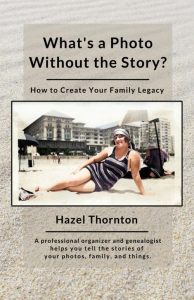
As featured in the 2023 Family Tree Magazine and The Photo Managers holiday gift guides.
If you’ve read my book, What’s a Photo Without the Story? How to Create Your Family Legacy, you know that I think everyone has stories to tell. Yes, even you! You don’t have to be a writer, an organizer, or a genealogist to capture your stories and there is no wrong way to do it. Readers have told me how much they appreciate the variety of suggested activities, ranging from low effort (do this if nothing else), to medium effort (your family will thank you), and high effort (ask for help if you need it).
Similarly, the following challenges, are designed for flexibility. You can personalize them all and do as much or as little as you like! You can write about yourself, or someone else. Even if you think you and your family are not worth telling stories about, you probably have photos or prized possessions that if something happened to you (and, trust me, it will) no one but you would know their significance.
If you don’t tell your stories, who will?
FREE year-long challenges 52 Photos in 52 Weeks — Legacy Photo Services (Teri Winfield) — This fun challenge is to guide you through telling the story of 52 family photos in 2024. Each week, you’ll be given a keyword to locate a photo in your collection. Add the story behind your photo for future generations to enjoy. Think: Who? What? When? Where? Details? All of the prompts are already listed on the website. But if you sign up you’ll get a weekly emailed prompt reminder. As Teri says, “If 52 photos sounds overwhelming, pick 12 of your favorite keywords. There are no rules!”
52 Ancestors in 52 Weeks — Amy Johnson Crow — You can blog, post on your favorite social media, send an email to your cousins — whatever you want to do to share something about the ancestor that each weekly prompt brings to mind. You could share a photo, make a video, record yourself talking. The point is to do something.
Write 24 in ’24 — Happier podcast (with co-hosts Gretchen Rubin and her sister Elizabeth Craft) — Depending on your goals, your specific project, and what’s manageable for you, you can write for 2 to 4 minutes or 24 minutes a day. The Happier app is free to download, and you can participate in the challenge and explore content with or without a subscription.
He doesn’t call it a challenge but genealogist Thomas MacEntee leads by example when he posts a memory each day on Facebook. It might be based on a well-known holiday such as Thanksgiving, or it might be something like National Cookie Day, or the day a vintage toy was first introduced. Then he asks about your memories. “So what is your favorite holiday cookie? Do you use a family recipe? What is the story behind the recipe?” You can answer privately or in a Facebook comment, keeping a copy for your records.
SUBSCRIPTION prompts and tools for yourself or a loved one: Write Your Life — Modern/Heirloom/Books (Dawn Roode) — 52 weeks of memory prompts, writing assignments, tips, and inspiration.
Storyworth — Often purchased as a gift. Step 1) Once a week, choose a question to inspire them to write. Step 2) They’ll simply reply with an email, which is shared with you. Step 3) At the end of a year, their stories are bound into a beautiful keepsake book.
Artifcts (no, it’s not misspelled) — From saving memories while decluttering, to preserving the value behind your things, Artifcts gives you a digital way to organize stuff and capture the meaning behind objects. (It’s a subscription, but you can try it for free.)
FREE family history writing prompts:Just Google “free family history writing prompts” for a plethora of ideas like these: FamilyTree prompts
WHERE to write and share your stories?
“Where” can mean where do I sit (desk, couch, coffee shop, etc.) but I’m talking right now about some examples of how and where to capture and share — but only if you want to — your stories.
Write alone, for yourself:
Paper notebookWord doc (or similar)Collaborate with family members:
Google DocsFamily Facebook pageShare your work with others:
WebsiteBlogNewsletterSubstack (online publishing platform)Online archive such as Permanent.org or Forever.comPublish as a book (independently or traditionally)Other types of memoirs
First, I’ve rarely encountered a word with so many sanctioned variations in pronunciation, most of which drive me crazy. For the record, I pronounce it “MEM-waar”, like in the first audio entry on this Google search.
Biopedia — This is a term coined by Latayne C. Scott, who learned the technique from Amy Krouse Rosenthal, and this is the YouTube interview that introduced me to it. If it doesn’t apply to you, just ignore the video’s title — Creating Your ‘Biopedia’ To Help You Market Your Books — and skip to the 3:00 mark to learn an easy approach to memoir writing. (At 10:03 host Derek Doepker talks about writing about an ordinary life.) Latayne uses (and teaches) a 3-T approach: 1. Tell – short stories, filed alphabetically. 2. Timeline — dates, events, places you lived, and a map, so you don’t have to give all that detail in each little biopedia entry. 3. Time Capsule — a slice of life right now, which may seem boring to us but which those in the future will find fascinating. On offer: free prompts for seniors (or anyone, I would imagine), and paid classes and other resources.
The Story Catalyst — Carolyn Flynn — I recently took her free class called “The Art of the Personal Essay”. Although I opted to not take the subsequent paid classes that promised to teach me more, I enjoyed it very much and was satisfied that the others would be good, too. Follow Carolyn to learn about her 2024 offerings.
The 10-7-5 Principle — Once upon a time I read Dr. Phil’s book Self Matters: Creating Your Life from the Inside Out (2001). He talked about the factors that have impacted our lives the most: 10 Defining Moments, 7 Critical Choices, and 5 Pivotal People. It occurred to me that these would be as good a framework for a memoir as any. Here’s an example of a random person (someone I don’t know and just now Googled up) who is using the 10-7-5 Principle.
Have you used any of these approaches to capturing the stories of your photos, family, and things? What else can you recommend? What might you try in the new year?
Please share with us in the comments below!
______________________________________________________Hazel Thornton is an author, genealogist, and retired home and office organizer.Hung Jury: The Diary of a Menendez Juror What’s a Photo Without the Story? How to Create Your Family Legacy Go With the Flow! The Clutter Flow Chart Workbook Feel free to link directly to this post! Click here to ask about other uses.Copyright 2023 by Hazel Thornton, Organized for Life and Beyond
___________________________________________________________
The post Storytelling Made Easy — Prompts & Challenges appeared first on Hazel Thornton.
November 27, 2023
Some books make better gifts than others
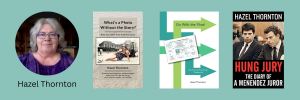
Books make terrific gifts, don’t they?
Well, not all of them.
Some books make better gifts than others.
I think we all know to consider the recipient’s taste and whether or not they enjoy reading. Otherwise, a book might quickly become clutter. But there are other considerations.
Like what?
Take mine, for example:
 Hung Jury: The Diary of a Menendez Juror
Hung Jury: The Diary of a Menendez Juror
This glimpse inside one of the most famous trials of the 1990’s makes an ideal gift for:
Menendez supportersTrue crime buffsLawyersThose who study juriesTeenage girls (or so I’ve heard)Caution: Many people who believed the prosecution-biased media coverage have said they changed their minds about the case once they read my book. But those people usually already knew, liked, and trusted me personally. It’s worth a try, though, if changing minds is your goal.
What’s a Photo Without the Story? How to Create Your Family Legacy

This how-to book is a perfect choice for:
YourselfYour family’s history keeperPhoto organizers and their clientsGenealogistsStorytellersThose wanting to downsize their possessions and leave a legacy, not a burdenAs seen in Family Tree Magazine and The Photo Managers holiday gift guides!
There are really no downsides to this one. Lots of folks buy this book as a gift intending to read it first themselves. Or, they buy multiple copies!
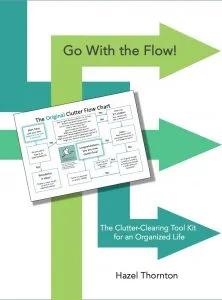 Go With the Flow! The Clutter Flow Chart Workbook
Go With the Flow! The Clutter Flow Chart Workbook
This workbook is an excellent choice for:
YourselfProfessional organizers buying it for themselves and their clients (so they can work through it together)Someone who not only wants to declutter but has also expressed that they cannot afford to hire a professional organizer, or they’ve literally put it on their wish listOtherwise, think twice, and read this blog post before purchasing it as a gift. Spoiler alert: It would be like buying a Weight Watchers membership for an overweight friend who didn’t ask for one!
Q: What would make the best FREE gift for the author in your life?
A: Amazon and/or Goodreads reviews!
10 FREE Ways to Support Your Favorite Authors
This blog post includes easy instructions for leaving quick reviews!
Many thanks to those who have already written reviews for my books!
What other considerations can you think of when giving a book as a gift?
Please share in the comments below!
Happy Holidays to you and yours!
That is, all the holidays and gift-giving occasions, all year round.
______________________________________________________Hazel Thornton is an author, genealogist, and retired home and office organizer.Hung Jury: The Diary of a Menendez Juror What’s a Photo Without the Story? How to Create Your Family Legacy Go With the Flow! The Clutter Flow Chart Workbook Feel free to link directly to this post! Click here to ask about other uses.Copyright 2014-2023 by Hazel Thornton, Organized for Life and Beyond
___________________________________________________________
The post Some books make better gifts than others appeared first on Hazel Thornton.
November 19, 2023
Menendez Media Fails
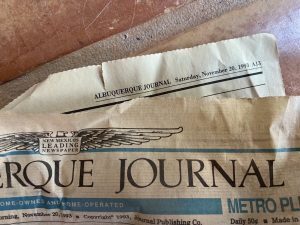
Albuquerque Journal, Saturday, Nov. 20, 1993
Menendez supporters all know how much the prosecution-biased media influenced public perception of the case during the four years preceding the actual first trial, during both trials, and in the decades since.
(You can Google famous examples such as the John Malkovich and Rob Schneider Saturday Night Live sketch and videos of Jay Leno making fun of them on The Tonight Show.)
Hence the still-pervasive, but false, greedy-rich-kids narrative.
The brothers are the butt of jokes (and are still imprisoned) to this day — thirty years later — as a result.
(View and download “Enough is Enough: The Menendez Tapestry” here.)
I could write a whole ‘nother book about it.
But all I want right now is to show you something that recently brought it all back for me.
What does my new bathroom — and a crumpled up section of newspaper — have to do with the Menendez brothers?
Click To Tweet
I had my bathroom remodeled in September 2023. My mirror covers a hole in the wall that I never think about unless, like during construction, the mirror is removed from the wall.

This time I noticed, in the space between the walls, some crumpled up newspaper. I removed it to see how old it was and if there was anything of interest. The date was Saturday, November 20, 1993.
Hmmm…I was on jury duty at that time.
I saw nothing interesting (to me) in the newspaper, aside from the date, not even old ads worth keeping or photographing. Certainly nothing about the Menendez trial, which was of nation-wide interest, but nowhere as intensely as it was in Los Angeles County, where the trials were held. (I moved to Albuquerque, New Mexico in 2005.)
I got curious, and opened my book — Hung Jury: The Diary of a Menendez Juror — to see what had happened the day before that might have been newsworthy on November 20th.
FRIDAY, NOVEMBER 19, 1993
The prosecution’s rebuttal phase is, so far, just like an arcade game in which they line their witnesses up like ducks in a row and Abramson shoots them all down — blam, blam, blam — five in a row.
(This excerpt appears in my “30 years ago today” @menendezjuror TikTok campaign, which is running, with posts every few days, from June 2023 – January 2024. )
I proceeded to detail each witness’ testimony — we later referred to them as “testi-liars” — and how they were caught in their lies.
I remember thinking surely this would be a good day for the defense in terms of news.
(By now I had heard the bulk of the prosecution’s and the defense’s cases, and was leaning towards the defense. But I still had to wait until the trial was over to find out what was being reported.)
Was this the headline the next day, as it should have been?
Abramson Catches Five Prosecution Witnesses Lying
Nooo! Of course it wasn’t! Instead, it was this:
Pool Repairman Disputes Claim by Menendezes
(LA Times article by Alan Abrahamson)
Seriously?
Impossible to avoid ALL news of the trialFor someone who was admonished daily by the judge to avoid news of the trial, I mentioned the media rather a lot in my book because it was impossible to avoid ALL news of the trial.
Take this diary entry for example:
No unbiased jurors left for second trial
MONDAY, SEPTEMBER 27, 1993
I can’t believe how many mistakes I’ve heard the media make in the little bits of news I’ve been unable to avoid. For example, Channel 7 had a caption indicating that “Leslie Bozanich” was the pictured speaker. Well, I’m sorry, but it’s either Leslie Abramson or Pamela Bozanich, and there’s a big difference! Also the radio said, “Lyle will take the stand today. . . . Erik finished his testimony Friday” (it was just the opposite), and at the very beginning of the trial I remember hearing or seeing the name of the wrong judge used because we were using another judge’s courtroom during jury selection. This has been a real lesson in trusting the media—if they can screw up little details like these, no wonder we are admonished to avoid the news.
As I wrote to the Editor of the Los Angeles Times after the trial (scroll to bottom of this link):
______________________________________________________Hazel Thornton is an author, genealogist, and retired home and office organizer.
Doesn’t anyone in this town understand the concepts of “reasonable doubt” and “burden of proof”? I voted for voluntary manslaughter in the case of People vs. Erik Menendez because the prosecution failed to prove that Erik is guilty of first-degree murder, not because I am “so enamored with Abramson and her argument,” as Alan Abrahamson wrote (news analysis, Jan. 30).
If this is the kind of reporting your readers have been relying on these past six months, I doubt there is an unbiased potential juror left in the whole state.
Has anyone bothered to notice that no one on the Erik Menendez jury voted for involuntary manslaughter, much less acquittal? I don’t call up to 11 years in prison for each count of manslaughter “getting away with it.”
HAZEL THORNTON, Juror No. 9, Lake View Terrace

Hung Jury: The Diary of a Menendez Juror What’s a Photo Without the Story? How to Create Your Family Legacy Go With the Flow! The Clutter Flow Chart Workbook Feel free to link directly to this post! Click here to ask about other uses.Copyright 2023 by Hazel Thornton, Organized for Life and Beyond
___________________________________________________________
The post Menendez Media Fails appeared first on Hazel Thornton.


